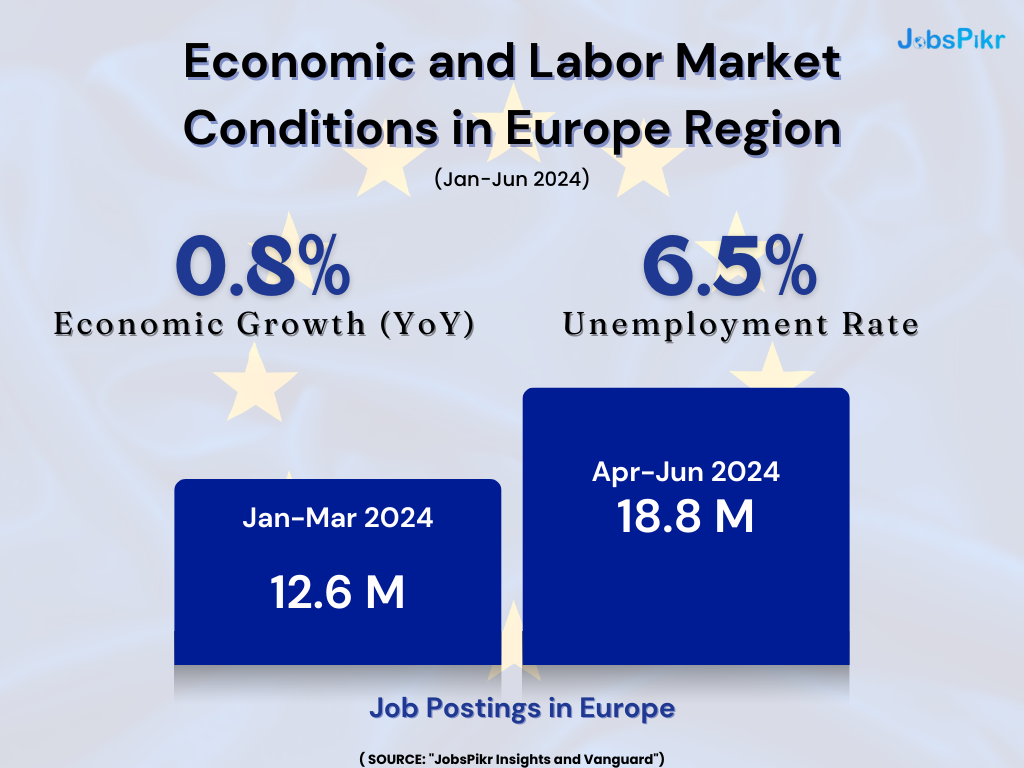Economic and Labor Market Conditions in Europe: Insights and Trends for 2024

As we move further into 2024, the economic landscape of Europe presents a dynamic and evolving picture. The euro area has shown resilience, but underlying challenges continue to influence labor market conditions. This article examines the economic growth, unemployment trends, and job market shifts that are shaping hiring patterns across the region, offering valuable insights for businesses, HR professionals, and job seekers.
Economic Growth: Navigating a Fragile Recovery
The euro area’s economy continues to tread a cautious path of recovery, registering a year-over-year growth of 0.8%. While this growth reflects the region’s ability to withstand global pressures, it remains modest and uneven across member states. The second quarter of 2024 saw a GDP increase of 0.3% compared to the first quarter, but this growth masks significant disparities, particularly in Germany, where the manufacturing sector continues to struggle.
Germany, often seen as the economic engine of Europe, has been facing a prolonged manufacturing slump that has dampened overall growth prospects. Despite this, the broader euro area has managed to maintain its growth trajectory, supported by robust consumer spending and government stimulus measures. However, as the two-year manufacturing downturn drags on, there are concerns that it could spill over into other sectors, potentially slowing down the recovery.
Looking ahead, the third quarter is expected to bring slower growth as the euro area grapples with these challenges. The European Central Bank (ECB) has maintained a cautious stance, signaling that while interest rate hikes might stabilize inflation, they could also dampen economic activity. For businesses, this environment necessitates a careful balancing act between managing costs and sustaining growth.
Unemployment Trends: Stability Amid Uncertainty
The euro area’s unemployment rate has remained relatively stable at 6.5% through 2024, reflecting a labor market that, while tight, is still navigating significant uncertainties. This stability, however, belies the underlying pressures faced by employers, particularly in sectors where profit margins have been squeezed.
As inflationary pressures begin to normalize, companies may find it increasingly challenging to sustain the profit margins that allowed them to absorb higher wage demands during the height of inflation. This could lead to a reassessment of hiring strategies, particularly if profit margins continue to narrow. The risk is that without the cushion of higher margins, companies may resort to cost-cutting measures, including potential layoffs or hiring freezes.
Moreover, the tight labor market has kept wages elevated, further contributing to the pressure on corporate profitability. While this has been beneficial for workers, it presents a dilemma for businesses that are already navigating a complex economic environment. The challenge will be to maintain a balance between rewarding employees and ensuring long-term financial stability.
Job Market Trends: A Surge in Opportunities
Despite the economic uncertainties, the European job market has shown remarkable resilience, with a significant uptick in job postings. Data from JobsPikr reveals that the number of job postings increased from 12.6 million in Q4 2023 (January to March 2024) to 18.8 million in Q1 2024 (April to June 2024). This 49% increase suggests a robust demand for labor, driven by several factors.
First, many industries that were heavily impacted by the pandemic, such as tourism, hospitality, and retail, have seen a strong rebound as restrictions eased and consumer confidence returned. This has led to a surge in hiring, particularly in countries where these sectors play a significant role in the economy.
Second, the digital transformation across industries has continued to accelerate, creating demand for tech-savvy professionals in IT, digital marketing, cybersecurity, and data analytics. The shift towards remote work and digital services, which began as a necessity during the pandemic, has now become a permanent feature of the labor market, driving new opportunities for workers with the right skills.
Finally, there has been a growing focus on sustainability and green technologies, spurred by both government initiatives and consumer demand. This has led to an increase in job opportunities in sectors such as renewable energy, electric vehicles, and environmental consulting.
The Road Ahead: Adapting to a Changing Landscape
As we progress through 2024, the interplay between economic growth, unemployment, and job market dynamics will continue to shape the labor market in Europe. For businesses, staying agile and responsive to these shifts is essential. Hiring strategies will need to be adapted to account for economic uncertainties, wage pressures, and evolving industry demands.
For job seekers, understanding these trends is crucial for navigating the job market effectively. The data from JobsPikr highlights the importance of being adaptable and ready to capitalize on opportunities as they arise, particularly in emerging sectors like digital technology and green energy.
HR professionals and recruiters will also need to leverage data-driven insights to optimize their talent acquisition strategies. By staying informed about regional variations and industry-specific trends, they can better align their recruitment efforts with the evolving needs of the market.
Conclusion
Europe’s economic and labor market conditions in 2024 present a complex but navigable landscape. While challenges persist, particularly in sectors like manufacturing, there are also significant opportunities for growth and innovation. By closely monitoring key indicators like economic growth and unemployment, and by leveraging the latest job market data from platforms like JobsPikr, businesses and job seekers can position themselves to thrive in this dynamic environment.
As the year unfolds, the ability to adapt to changing conditions will be the key to success, whether you are a business looking to expand your workforce or a job seeker aiming to secure the next step in your career. Sign up today!


